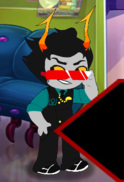Homestuck is once again lit up over fan merch. Homestuck and fan merch have a long and troubled history, but this latest incident is between artists, Redbubble, and Viz media. Here are my thoughts on that!
In late May 2021, artists who sold Homestuck merch on Redbubble got this email:
Dear [name],
Thank you for submitting your fan art for Homestuck and/or Hiveswap as part of Redbubble’s Fan Art Partner Program.
At this time, our partnership with the rights holder VIZ Media has come to an end. When a partnership expires, we are required to remove officially approved artworks from the marketplace. This means that your Homestuck and/or Hiveswap designs will be removed from Redbubble soon.
Here are a couple of things to keep in mind:
- It is important to know that licensors do not allow previously approved designs once sold on Redbubble to be sold on any other platform, even after the program ends.
- Because this removal is not in response to a complaint, your account will not be negatively impacted.
Partnerships come and go, but don’t worry. We’re looking forward to partnering with more awesome brands in the future.
Check out our Current Brand Partnerships list to see all the properties that are actively accepting submissions. For additional information, we recommend checking out the Fan Art Partner Program FAQ.
Thank you,
Redbubble
This hit a lot of people, and hit them hard:
Rut-roh!
Unfortunately for Twitter and brevity this is actually the intersection of a couple different complicated issues, which I’ll try to summarize here.
Copyright law really sucks for fanartists, actually
Just gonna get this one out of the way right off the bat. Copyright law gives IP owners a tremendous amount of power over what’s done with their characters and designs, even extending far into derivative fanart. If you own Homestuck, you actually can take someone to court over selling merch of their fantroll, and probably win. That’s not a great starting point, but it’s the truth.
Eevee has a great write-up of why this is bad. I’d also point you to Tom Scott’s video about how copyright law isn’t designed for intermediate platforms like Redbubble, but suffice it to say, yeah, copyright law really sucks for fanartists, actually.
This is the most complex thing going on here, certainly, but it’s not new and interesting. What is new and interesting, though, is
Redbubble forcing predatory licensing on people
Now, copyright law sucks for fanartists, but that doesn’t explain what happened here.
 FSE sprite compression
FSE sprite compression
 Is homestuck.giovanh.com official?
Is homestuck.giovanh.com official?

 Polygon's "Life after Homestuck" (Thread)
Polygon's "Life after Homestuck" (Thread)







